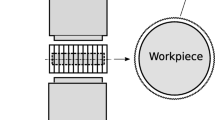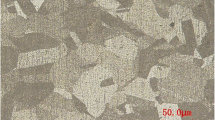Abstract
Flash line is one of the most important surface defects in coining process of silver commemorative coin. Due to the deficiency of study on the defect mechanism, it takes a long time to eliminate the defect through die tryouts which bring significant instabilities and development costs in coin manufacture. In the present investigation, the mechanism of flash line is studied by the elimination solutions and metal flow analysis using the finite element method (FEM). The radial components of friction in die–workpiece interface are considered as the main reasons of the defect. A modified friction model considering the influence of the sliding velocity in the die–workpiece interface is employed to describe the frictional behaviors in coining more properly. A novel radial friction work (RFW) model is proposed to predict the tendency of flash line and employed to a dynamic explicit FEM system for coining-COINFORM. The comparisons of the numerical and experimental results of a typical silver coin demonstrate that the RFW model is valid in the prediction of flash line.
Similar content being viewed by others
References
Kobayashi S, Oh SI, Altan T (1989) Metal forming and the finite element method. Oxford University Press, New York
China Banknote Printing and Minting Corporation (2006) Training materials in banknote printing and minting industry: the Coinage of Metallic Coins (Confidential). Beijing
Zhou D, Wagoner RH (1995) Development and application of sheet-forming simulation. J Mater Process Technol 50:1–16. doi:10.1016/0924-0136(94)01366-9
Li G, Jinn JT, Wu WT, Oh SI (2001) Recent development and applications of three-dimensional finite element modeling in bulk forming processes. J Mater Process Technol 113:40–45. doi:10.1016/S0924-0136(01)00590-8
Liu W, Guo Y, Tang S, Belytschko T (1998) A multiple-quadrature eight-node hexahedral finite element for large deformation elastoplastic analysis. Comput Methods Appl Mech Engrg 154:69–132. doi:10.1016/S0045-7825(97)00106-0
Xie C, Dong X, Li S, Huang S (2000) Rigid-viscoplastic dynamic explicit FEA of the ring rolling process. Int J Mach Tool Manu 40:81–93. doi:10.1016/S0890-6955(99)00043-7
Chan LC, Fu MW, Li N, Lu J (2010) FEA-aided design of multi-stage drawing process and tooling for production of a miniature sheet metal component. Int J Adv Manuf Technol 46:993–1000. doi:10.1007/s00170-009-2163-z
Hambli R, Soulat D, Chamekh A (2009) Finite element prediction of blanking tool cost caused by wear. Int J Adv Manuf Technol 44:648–656. doi:10.1007/s00170-008-1859-9
Hallquist J (2006) LS-DYNA Theory Manual. http://www.dynasupport.com/manuals/additional/ls-dyna-theory-manual-2005-beta/view. Accessed 26 July 2008
Leitao PJ, Teixeira AC, Rodrigues JMC, Martins PAF (1997) Development of an industrial process for minting a new type of bimetallic coin. J Mater Process Technol 70:178–184. doi:10.1016/S0924-0136(97)02914-2
Fabbri R (2001) The design of a new coin. The Art of Minting 2:42–48
Fabbri R (2001) The design of a new coin. The Art of Minting 3:52–54
Ike H, Plancak M (1998) Coining process as a means of controlling surface microgeometry. J Mater Process Technol 80–81:101–107. doi:10.1016/S0924-0136(98)00101-0
Buffa G, Fratini L, Micari F (2007) The relevance of the preform design in coining processes of cupronickel alloy. AIP Conf Proc 908:1005–1010. doi:10.1063/1.2740942
Xu JP, Liu YQ, Li SQ, Wu SC (2008) Fast analysis system for embossing process simulation of commemorative coin–COINFORM. Comput Model Eng Sci 38(3):201–216. doi:10.3970/cmes.2008.038.201
Xu JP (2009) Study on minting process simulation algorithm for Au–Ag commemorative coin and optimization of forming process. Dissertation, Huazhong University of Science and Technology
Guo K (2009) Development of design tools for coining process using FEM. Dissertation, Carleton University
Malayappan S, Narayanasamy R (2004) An experimental analysis of upset forging of aluminium cylindrical billets considering the dissimilar frictional conditions at flat die surfaces. Int J Adv Manuf Technol 23(9–10):636–643. doi:10.1007/s00170-003-1584-3
Menezes PL, Kumar K, Kishore KSV (2009) Influence of friction during forming processes—a study using a numerical simulation technique. Int J Adv Manufact Tech 40(11–12):1067–1076
Ramezani M, Ripin ZM (2010) A friction model for dry contacts during metal-forming processes. Int J Adv Manuf Technol 51(1–4):93–102. doi:10.1007/s00170-010-2608-4
Jeon J, Bramley AN (2007) A friction model for microforming. Int J Adv Manuf Technol 33(1–2):125–129. doi:10.1007/s00170-006-0608-1
Tan X (2002) Comparisons of friction models in bulk metal forming. Tribol Int 35:385–393. doi:10.1016/S0301-679X(02)00020-8
Hayhurst DR, Chan MW (2005) Determination of friction models for metallic die-workpiece interfaces. Int J Mech Sci 47:1–25. doi:10.1016/j.ijmecsci.2004.12.008
Joun MS, Moon HG, Choi IS, Lee MC, Jun BY (2009) Effects of friction laws on metal forming processes. Tribol Int 42:311–319. doi:10.1016/j.triboint.2008.06.012
Petersen SB, Martins PAF, Bay N (1997) Friction in bulk metal forming: a general friction model vs. the law of constant friction. J Mater Process Technol 66:186–194. doi:10.1016/S0924-0136(96)02518-6
Petersen SB, Martins PAF, Bay N (1998) An alternative ring-test geometry for the evaluation of friction under low normal pressure. J Mater Process Technol 79:14–24. doi:10.1016/S0924-0136(97)00448-2
Altan T, Vazquez V (1996) Numerical process simulation for tool and process design in bulk metal forming. CIRP Ann-Manuf Techn 45:599–615. doi:10.1016/S0007-8506(07)60514-9
Chen CC, Kobayashi S (1978) Rigid plastic finite element analysis of ring compression. Applications of numerical methods to forming processes. ASMEAMD 28:163–174
Delamare F, Montmitonnet P (1984) Mechanical analysis of coin striking: application to the study of byzantine gold solidi minted in constantinople and carthage. J Mech Work Tech 10:253–271. doi:10.1016/0378-3804(84)90042-1
Brekelmans WAM, Mulders LHG, Ramaekers JAH (1988) The coining process: analytical simulations evaluated. CIRP Ann-Manuf Techn 37:235–238. doi:10.1016/S0007-8506(07)61625-4
Belytschko T, Wong BL, Plaskacz EJ (1989) Fission-fusion adaptivity in finite elements for nonlinear dynamics of shells. Comput Struct 33:1307–1323. doi:10.1016/0045-7949(89)90468-9
Rachowicz W, Pardo D, Demkowicz L (2006) Fully automatic hp-adaptivity in three dimensions. Comput Methods Appl Mech Engrg 195:4816–4842. doi:10.1016/j.cma.2005.08.022
Author information
Authors and Affiliations
Corresponding author
Rights and permissions
About this article
Cite this article
Zhong, W., Liu, Y., Hu, Y. et al. Research on the mechanism of flash line defect in coining. Int J Adv Manuf Technol 63, 939–953 (2012). https://doi.org/10.1007/s00170-012-3952-3
Received:
Accepted:
Published:
Issue Date:
DOI: https://doi.org/10.1007/s00170-012-3952-3




